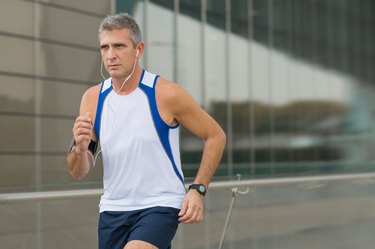
Capillaries are blood vessels only one cell thick. They are the smallest of all the blood vessels in your body and they allow for the exchange of oxygen, carbon dioxide, water and other nutrients and waste between the blood vessels and surrounding tissues. Capillaries will sometimes rupture or burst, which causes blood to pool under the skin. This forms a bruise.
Exercise
Video of the Day
There are two main reasons why exercise may cause ruptured capillaries. First, straining or lifting of any heavy object, as during a weightlifting session, can cause these tiny blood vessels in the face or eyes to rupture. Another cause is the direct pressure a heavy weight bar places onto the capillaries and other blood vessels in the body, as during a weighted barbell squat. Capillaries in the tops of the shoulders or back may rupture from the pressure.
Video of the Day
Broken Eye Capillaries
Broken capillaries in the eye are called subconjunctival hemorrhages. Any straining or heavy lifting – like in weight lifting – could cause the capillaries in the eye or eyes to burst. The blood vessels that rupture are located just under the clear surface of the eye and so appear as bright red spots in the whites of the eye. Usually lasting 10 to 14 days, the condition should not be painful, although it might feel irritated. The blood will reabsorb back into the eye and the appearance of the eye will return to normal on its own without treatment.
Risk Factors
People with diabetes or high blood pressure are at higher risk for developing subconjunctival hemorrhage during exercise. Other risk factors for broken capillaries in the eye are some medications like warfarin, and herbal supplements like ginkgo. People who smoke are also at higher risk of developing broken capillaries, especially in the nose area.
Prevention or Treatment
If you find you are prone to broken capillaries, first determine if you have any risk factors. In some cases, you may not be able to avoid developing broken capillaries. Otherwise, you may try to lighten the load you lift and see if that helps. Use padded weight bars when performing squats to protect the skin and blood vessels in your back and shoulders. The most effective treatment for permanently broken capillaries in the skin is laser therapy. Laser destroys the ruptured capillaries and the pooled blood gets reabsorbed into the body. This type of treatment should only be used by people with permanently ruptured capillaries. Otherwise, broken capillaries will heal without medical intervention.